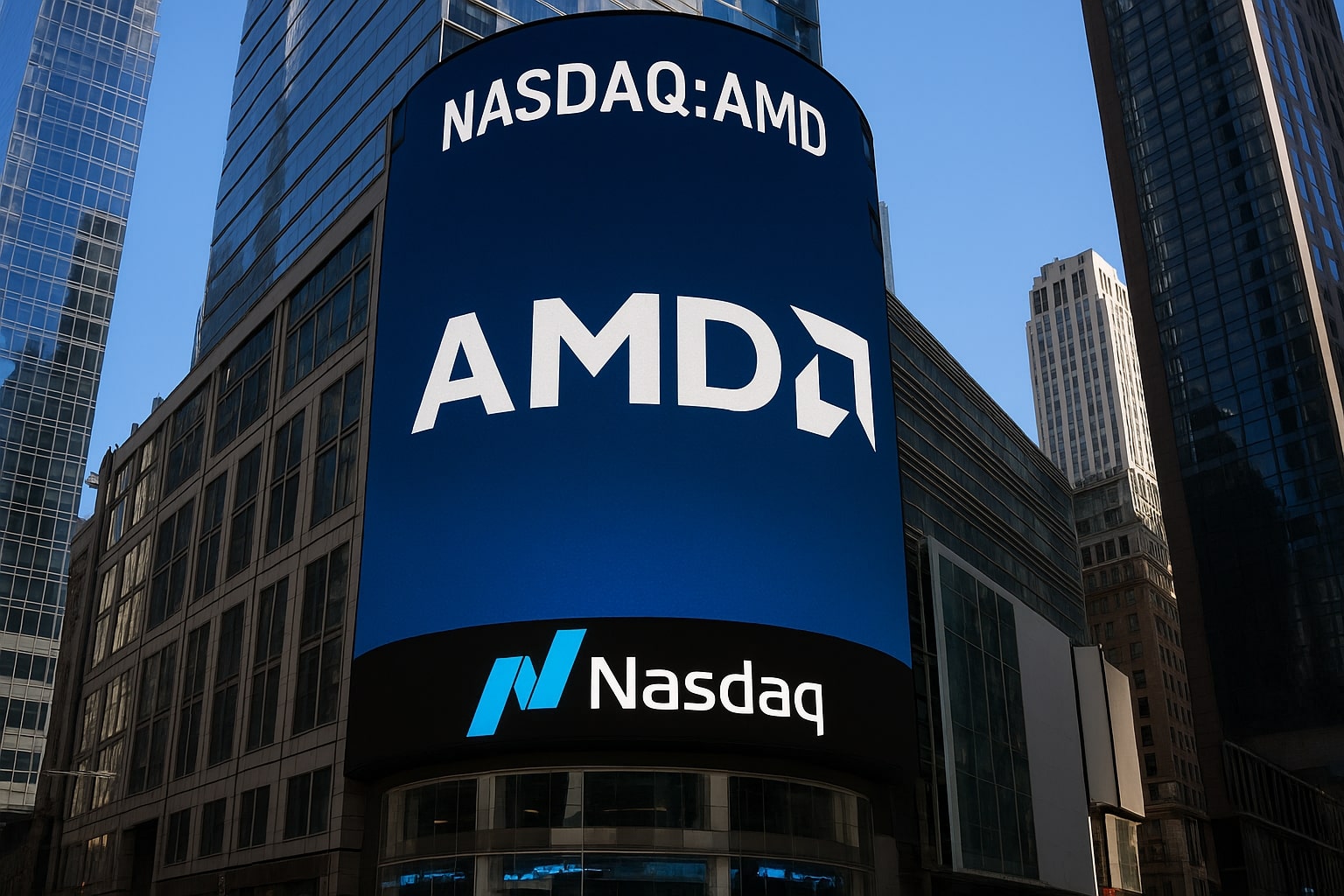
NASDAQ:AMD Stock Price Forecast – AI GPU Breakthroughs and Segment Growth Drive Bullish Outlook
Advanced Micro Devices builds momentum at $162 as MI355 GPUs, EPYC CPUs, and console wins fuel revenue growth toward $40B by 2026 | That's TradingNEWS
NASDAQ:AMD Stock Price Forecast – AI GPU Growth, Segment Recovery, and Valuation Dynamics
The stock price of Advanced Micro Devices (NASDAQ:AMD) is trading around $162 after sliding 0.22% intraday, reflecting cautious sentiment despite robust fundamentals. Shares remain well below the 52-week peak of $186.65 yet far above the low of $76.48, underscoring how much momentum AMD has regained in 2025. With a market capitalization of $263 billion, a trailing P/E near 97, and a forward multiple closer to 27, investors are increasingly debating whether AMD is still undervalued given its accelerating AI-driven revenue growth.
Financial Performance and Revenue Expansion
AMD closed fiscal 2024 with revenue of $29.6 billion, up 15% from 2023’s $25.8 billion, while net income more than doubled to $2.83 billion versus $1.64 billion a year earlier. Gross profit margins expanded to $14.1 billion, with EBITDA climbing to $5.6 billion. In Q2 2025, revenue surged 32% year-over-year to $7.7 billion, with the Client segment leading growth at $2.49 billion, up 67% year-over-year, while gaming revenue soared 73% to $1.12 billion. Data Center sales rose 14% to $3.24 billion despite U.S. export restrictions limiting shipments to China, which eliminated MI308 GPU sales during the quarter.
Operating income reached $2.45 billion in 2024, and analysts now forecast AMD will deliver $8.72 billion in Q3 revenue, up from $6.82 billion a year earlier. Consensus 2025 full-year sales are projected at $33 billion, rising to $40.1 billion in 2026. EPS is estimated at $3.90 in 2025 and $6.02 in 2026, with several bullish analysts suggesting upside toward $8 if AI sales scale faster.
AI GPU Momentum and Competitive Positioning
The release of AMD’s MI355 GPUs and upcoming MI400 lineup represents the company’s clearest path to market share gains against NVIDIA. Management projects that the global AI chip market will reach $500 billion by 2028, while independent forecasts place the opportunity as high as $1 trillion. AMD is targeting the inference market in particular, where its MI355 demonstrates as much as 40% more tokens per dollar than NVIDIA’s Blackwell B200. Major partnerships, including Oracle’s deployment of over 27,000 AI nodes powered by AMD accelerators and EPYC Turin CPUs, reinforce AMD’s progress.
At present, NVIDIA controls roughly 80–85% of the AI GPU market, but even a 15–20% share for AMD implies $100–$150 billion in revenue potential by 2030. Current analyst models, which cap AMD’s 2026 sales at $40 billion, likely underestimate the scale of this opportunity.
Client, Gaming, and Console Growth
Beyond AI, AMD’s Client division continues to expand as Intel loses share. Desktop CPU market share for AMD now sits above 33%, with unit share climbing toward 25%, compared to Intel’s declining 67.8%. Laptop adoption is strengthening as AMD powers Copilot-enabled devices that leverage local AI inferencing.
The gaming segment rebounded sharply in Q2 2025, generating $1.12 billion in revenue. The Radeon RX 9000 series GPUs have been well received, with demand exceeding supply, while console semi-custom sales surged on the back of Sony PlayStation 5 and Microsoft Xbox demand. AMD has secured multi-year design wins with both Microsoft and Sony for next-generation consoles, ensuring recurring revenue streams. With consoles making up roughly 20% of total costs in systems valued at $25–27 billion annually, AMD can expect $3.5–4 billion in yearly revenue from console SoCs alone.
Balance Sheet, Cash Flow, and Margins
AMD remains financially resilient with $5.87 billion in cash against $3.89 billion in total debt. Operating cash flow for the trailing twelve months reached $4.88 billion, with levered free cash flow at $2.33 billion. The company’s current ratio stands at 2.49, reflecting liquidity strength. Gross margin for the last twelve months was 50.9%, while profit margin registered at 9.57%. Management continues to raise R&D spending, up 20% in Q2, supporting aggressive product development.
However, Data Center margins remain pressured, posting -4.7% last quarter due to inventory write-downs and lost China sales. This was offset by 21.1% operating margins in Client and improved profitability in Gaming, showing the importance of mix-shift as AI volumes increase.
Read More
-
AbbVie Stock Price Forecast - ABBV at $229 Turns the Humira Cliff Into a 2026 Growth Engine
02.01.2026 · TradingNEWS ArchiveStocks
-
XRP Price Forecast - XRP-USD Nears $2 as $1.80 Support and Shrinking Supply Point to $2.60 Target
02.01.2026 · TradingNEWS ArchiveCrypto
-
Oil Price Forecast - Oil Slide Into 2026: WTI Stuck at $57, Brent at $60
02.01.2026 · TradingNEWS ArchiveCommodities
-
Stock Market Today: Nasdaq Hits 23,467 as Nvidia (NVDA), Micron (MU) and Baidu (BIDU) Drive AI Surge
02.01.2026 · TradingNEWS ArchiveMarkets
-
GBP/USD Price Forecast: Pound Holds 1.3450 as Fed–BoE Split Keeps Bulls Aiming at 1.37
02.01.2026 · TradingNEWS ArchiveForex
Valuation Metrics and Market Sentiment
At $162, AMD trades at a forward P/E of 27, with a PEG ratio of 0.50, suggesting attractive valuation relative to peers. By comparison, NVIDIA’s forward P/E remains above 40, Arm Holdings trades at a PEG of 3.3, and Broadcom sits near 2.0. AMD’s valuation compresses further when modeling EPS acceleration beyond consensus—if earnings reach $8 by 2026, the stock is trading near 20x forward earnings, an attractive multiple for a company compounding revenue 20–30% annually.
Institutional ownership stands at 69.41%, with insiders holding just 0.5%. Insider transactions have been limited, suggesting little executive selling pressure despite the stock’s near-doubling from April lows. Short interest sits below 3%, indicating modest bearish bets.
Analyst Targets and Rating Shifts
Wall Street analysts remain broadly bullish. Stifel, Benchmark, Raymond James, and Piper Sandler have reiterated Buy or Overweight ratings, with price targets clustered around $190–$210. Mizuho recently reaffirmed its $205 target, while Rosenblatt also holds a $200 target. Truist upgraded AMD to Buy in late August, underscoring renewed confidence in execution. The average analyst target is $185.65, with the most bullish view pointing to $230.
Outlook for NASDAQ:AMD
The stock has pulled back to $162 after rallying 115% since April, yet the AI cycle and continued CPU market share gains provide a strong growth runway. Risks remain in execution, China export restrictions, and aggressive competition from NVIDIA and Arm-based alternatives. Still, with forward earnings revisions trending higher, valuation compression, and product momentum building, the long-term trajectory favors further upside.


















